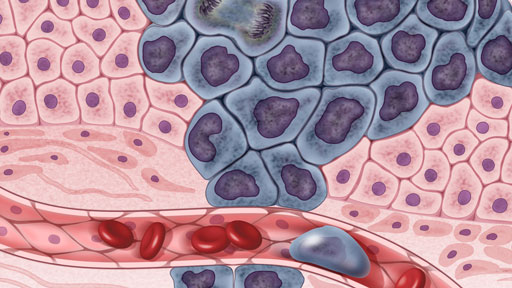TCGA is jointly funded and managed by the National Cancer Institute (NCI) and the National Human Genome Research Institute (NHGRI), both part of the National Institutes of Health. A TCGA analysis of another, less common, form of lung cancer, squamous cell carcinoma, was reported in 2012.
In this new study, published online July 9, 2014, in the journal Nature, researchers examined the genomes, RNA, and some protein from 230 lung adenocarcinoma samples. In three-quarters of the samples, the scientists ultimately identified mutations that put a cell signaling pathway known as the RTK/RAS/RAF pathway into overdrive.
"The integrated nature of TCGA analysis made these findings and their potential therapeutic implications possible," said NIH Director Francis S. Collins, M.D., Ph.D. "We hope this lays the groundwork for future work in precision medicine."
Mutations affecting the RTK/RAS/RAF pathway can cause it to become stuck in the "on" state. As a result, signals that promote cancer cell proliferation and survival are produced continuously. However, some drugs currently available curb aberrant activity of this pathway and prompt therapeutic responses in patients.
"Combined with the earlier TCGA analysis of squamous lung cancers, we now have a comprehensive understanding of many of the genetic pathways that lead to cancers of the lung," said NCI Director Harold Varmus, M.D. "Based on this knowledge, we can now seek better pathway inhibitors to improve patient outcomes. However, for the time being, stopping smoking or never starting remains the most reliable ways to reduce the number of deaths due to lung cancer."
In the group's initial scan of tumor samples, researchers identified gene mutations that would increase RTK/RAS/RAF pathway activity in 62 percent of the samples. The affected genes are oncogenes, or genes that have the potential to cause cancer when mutated or expressed at high levels. Consequently, these tumor samples were classified as oncogene-positive.
To identify additional alterations, the investigators looked at DNA copy number changes, or changes in gene number resulting from the deletion or amplification (multiplication) of sections of DNA in the genome. In doing so, they detected amplification of two oncogenes, ERBB2 and MET, which are part of the RTK/RAS/RAF pathway. Gene amplification usually leads to increased expression of the encoded protein in cells.
Now that these amplifications have been identified, clinicians may be able to treat patients whose tumors have specific gene changes with drugs currently available or under development.
"It is quite striking that we have now identified an actionable mutation in over 75 percent of patients with lung adenocarcinoma, a significant improvement from a decade ago," said Matthew Meyerson, M.D., Ph.D., Harvard Medical School, Dana-Farber Cancer Institute, The Broad Institute, and one of the lead investigators on the project.
Additional analysis identified other genes that may play important roles in lung cancer development. Mutations in one of these genes, NF1, had previously been reported in lung cancer; NF1 is a known tumor suppressor gene that regulates the RTK/RAS/RAF pathway. Mutations in NF1 also put the pathway into overdrive. Another mutated gene, RIT1, is also part of the RTK/RAS/RAF pathway, and this is the first study to associate mutation of this gene with lung cancer.
"This most recent TCGA study again demonstrates the power, depth and breadth of TCGA data," said NHGRI Director Eric Green, M.D., Ph.D. "These results give us important new genomic insights into the development and behavior of an important form of cancer."
In the aggregate, the several forms of lung cancer comprise the most common cause of cancer-related deaths worldwide, with more than 1 million deaths annually. NCI estimates that only 17.5 percent of people diagnosed with lung cancer are still alive five years later.
Lung adenocarcinoma, the most common form of the disease in the United States, develops in tissues near the outer parts of the lungs and can spread widely. Although smoking is the main risk factor, adenocarcinoma is also the most common type of lung cancer among lifelong non-smokers and the risk of lung cancer is increased by 20 percent to 30 percent by exposure to secondhand smoke.
In addition to the two lung cancer studies, the TCGA Research Network has generated data and published analyses on a number of cancers, all of which can be found on the TCGA website, www.cancergenome.nih.gov. TCGA-generated data are freely available at the TCGA Data Portal and CGHub.
This work was supported by the following NIH grants: U24 CA126561, U24 CA126551, U24 CA126554, U24 CA126543, U24 CA126546, U24 CA137153, U24 CA126563, U24 CA126544, U24 CA143845, U24 CA143858, U24 CA144025, U24 CA143882, U24 CA143866, U24 CA143867, U24 CA143848, U24 CA143840, U24 CA143835, U24 CA143799, U24 CA143883, U24 CA143843, U54 HG003067, U54 HG003079 and U54 HG003273.
Reference: The Cancer Genome Atlas Network authors. Comprehensive Molecular Profiling of Lung Adenocarcinoma. Nature, July 9, 2014. DOI: 10.1038/nature13385.
The TCGA Research Network consists of more than 150 researchers at dozens of institutions across the nation. A list of participants is available at http://cancergenome.nih.gov/abouttcga/overview. More details about The Cancer Genome Atlas, including Quick Facts, Q&A, graphics, glossary, a brief guide to genomics and a media library of available images can be found at http://cancergenome.nih.gov.
NCI leads the National Cancer Program and the NIH effort to dramatically reduce the burden of cancer and improve the lives of cancer patients and their families, through research into prevention and cancer biology, the development of new interventions, and the training and mentoring of new researchers. For more information about cancer, please visit the NCI website at http://www.cancer.gov or call NCI's Cancer Information Service at 1-800-4-CANCER (1-800-422-6237).
NHGRI is one of the 27 institutes and centers at the National Institutes of Health, an agency of the Department of Health and Human Services. The NHGRI Division of Intramural Research develops and implements technology to understand, diagnose and treat genomic and genetic diseases. Additional information about NHGRI can be found at its website, http://www.genome.gov.
About the National Institutes of Health (NIH): NIH, the nation's medical research agency, includes 27 institutes and centers and is a component of the U.S. Department of Health and Human Services. NIH is the primary federal agency conducting and supporting basic, clinical, and translational medical research, and is investigating the causes, treatments, and cures for both common and rare diseases. For more information about NIH and its programs, visit ttp://www.nih.gov.



